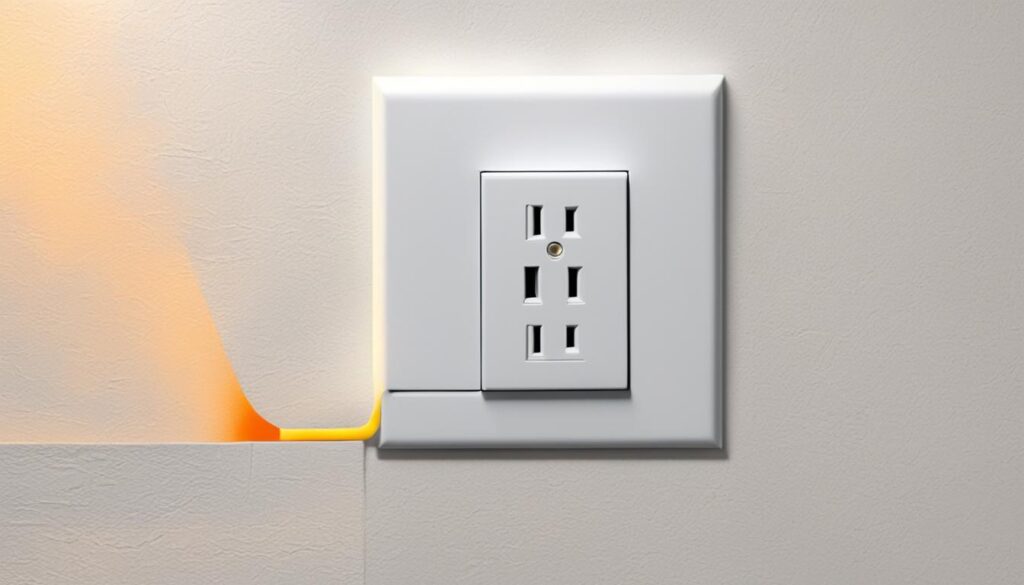This post contains affiliate links.
Did you know that electrical issues are one of the leading causes of residential fires in the United States? Every year, thousands of homes are affected by electrical faults and malfunctions, causing devastating damage and even loss of lives.
It’s crucial to address common electrical problems in your home to ensure the safety and functionality of your electrical system. By understanding and troubleshooting these issues, you can mitigate the risk of electrical hazards and maintain a secure living environment.
Key Takeaways:
- Electrical problems can pose serious safety risks and can lead to house fires.
- Addressing common electrical problems ensures the safety and functionality of your home’s electrical system.
- Some issues can be resolved through DIY troubleshooting, but it’s best to consult a professional electrician for complex problems.
- Regular electrical inspections are recommended to identify and fix potential issues before they become major problems.
- Prioritize your home’s electrical maintenance to protect your loved ones and property.
Lights Switch Not Working
If you’ve ever experienced a light switch that doesn’t work properly, you know how frustrating it can be. The simple act of turning on a light should be effortless, but when you struggle with an unreliable or defective switch, it can lead to inconvenience and annoyance.
There are several possible reasons behind a light switch not working as expected. Defective parts, installation errors, or the age of the switch itself could all be contributing factors. To troubleshoot the issue, there are a few steps you can take to identify and potentially resolve the problem.
First, check the bulb connected to the switch. It’s possible that a burnt-out bulb is causing the apparent malfunction. Try replacing the bulb with a new one and see if that resolves the issue.
If the bulb isn’t the problem, the next step is to inspect the circuit breaker. A tripped circuit breaker can cause the light switch to stop functioning. Go to your electrical panel and check if any breakers have been tripped. If you find a tripped breaker, switch it off and then back on to reset it. This might solve the issue.
Finally, examine the outlet located near the light switch. Ensure that it is functional and providing power. If the outlet itself is defective or not supplying electricity, it could be influencing the switch’s performance. Consider testing the outlet with a different device or consulting an electrician for further assistance.
Remember, when dealing with electrical troubleshooting, it’s important to exercise caution. If the issue persists or you’re unsure about handling the problem yourself, it’s recommended to call a professional electrician. They possess the knowledge and expertise to identify and fix any underlying electrical faults.
| Possible Causes of a Light Switch Not Working | Troubleshooting Steps |
|---|---|
| Defective parts | Check and replace the bulb |
| Installation errors | Inspect the circuit breaker and reset if necessary |
| Age of the switch | Examine the outlet near the switch |
Lots of Electrical Surges
If you’ve been experiencing frequent electrical surges in your home, it’s essential to address this common issue promptly. Electrical surges can not only disrupt the functioning of your appliances but also pose a risk of damaging your electronic devices. Additionally, they might indicate underlying problems with your home’s wiring or faulty devices. To ensure the safety and reliability of your electrical system, it’s highly recommended to have a professional electrician conduct a thorough electrical inspection.
An electrical inspection will help identify the source of the surges and determine if there are any wiring issues or faulty devices contributing to the problem. By detecting and addressing these issues early on, you can prevent further damage and protect your appliances and electronics.
Signs of Electrical Surges
It’s important to be aware of the signs that indicate electrical surges in your home. These can include:
- Flickering or dimming lights
- Devices randomly shutting down or restarting
- Appliances malfunctioning or failing prematurely
- Burning smell coming from outlets or switches
If you notice any of these signs, it’s crucial to take action and schedule an electrical inspection to address the issue before it worsens.
Importance of Professional Inspection
While you may be tempted to troubleshoot electrical surges on your own, it’s always best to rely on the expertise of a professional electrician. They have the necessary knowledge and experience to identify the root cause of the surges and implement the appropriate repairs.
A professional electrician will thoroughly examine your electrical system, including the wiring, circuit breakers, outlets, and devices, to pinpoint any faulty components or potential wiring issues. They will also assess the overall safety of your electrical system to ensure compliance with electrical codes and regulations.
Based on their findings, the electrician will recommend and carry out the necessary repairs or replacements, safeguarding your home against future electrical surges and reducing the risk of damage to your appliances and electronics.
Remember, electrical surges are not only a nuisance but also a potential hazard. Don’t ignore the issue or attempt to handle it yourself without the right expertise. Instead, reach out to a professional electrician who can provide the expertise and solutions you need to protect your home and its electrical system.

Circuit Breaker Tripping
If you find that your circuit breaker is frequently tripping, it could be a sign of an overloaded circuit. This can happen when you have too many devices or appliances connected to the same circuit, exceeding its capacity. To troubleshoot the issue and prevent further tripping, follow these steps:
- Unplug devices: Start by unplugging any devices that are connected to the overloaded circuit. This will help reduce the load on the circuit and prevent it from tripping.
- Identify the cause: Once you have unplugged the devices, try to identify the specific appliance or equipment that may be causing the overload. Look for devices that consume a lot of power, such as air conditioners, heaters, or high-wattage appliances.
- Distribute the load: If you have identified the cause of the overload, consider redistributing the devices across multiple circuits. This will help balance the load and prevent any single circuit from becoming overloaded.
- Upgrade your electrical system: In some cases, the circuit breaker may be tripping due to an outdated electrical system. If you frequently experience circuit breaker trips or have a consistent need for additional power, it may be time to consider an electrical upgrade. Consult a professional electrician to assess the capacity of your current system and recommend the necessary upgrades.
Remember, an overloaded circuit can pose a fire hazard and compromise the safety of your home. It is essential to consult a professional electrician for an accurate diagnosis and to ensure that any necessary electrical upgrades are carried out safely.
Consider this scenario:
You’re in the middle of cooking a delicious meal when suddenly, all the lights in your kitchen go out. Frustrated, you head to the electrical panel to find that the circuit breaker has tripped again. This is not only inconvenient but also a potential safety hazard.
Dealing with a tripping circuit breaker can be frustrating, but it’s important to address the issue promptly to avoid further electrical problems. By following the troubleshooting steps mentioned above and consulting a professional electrician, you can ensure the safety and reliability of your home’s electrical system.
| Common Causes of Circuit Breaker Tripping | Preventive Measures |
|---|---|
| Overloaded circuit due to excessive power consumption | Redistribute the load across multiple circuits |
| Outdated electrical system | Consider upgrading your electrical system |
| Faulty wiring or appliances | Consult a professional electrician for diagnosis and repairs |
| Loose electrical connections | Regularly inspect and tighten connections |
Outlets or Switches are Warm
Warm outlets or light switches are not only an inconvenience but also a potential fire hazard. When outlets or switches feel warm to the touch, it indicates an underlying electrical issue that requires immediate attention.
Electrical outlets and switches should never be warm or hot. The presence of heat suggests excessive electrical resistance, which can lead to overheating and potentially cause a fire. Ignoring this warning sign can put your family’s safety at risk.
If you notice warm outlets or switches in your home, it is crucial to take immediate action:
- Turn off the breaker: Locate the breaker that controls the affected outlet or switch and switch it off to cut power to the area. This will help prevent further electrical issues.
- Contact a professional electrician: Do not attempt to fix the problem yourself, as electrical issues can be complex and dangerous. Contact a licensed electrician who has the expertise to diagnose and resolve the issue safely.
A professional electrician will perform a thorough inspection of the affected outlet or switch to identify the root cause of the warmth. Common causes may include loose wiring, overloaded circuits, or faulty connections.
Additionally, the electrician will take the necessary steps to rectify the problem, which may involve tightening connections, replacing damaged components, or upgrading the electrical system if needed.
Remember, never ignore warm outlets or switches, as they can pose a significant risk to your home and family’s safety. By promptly addressing electrical issues with the help of a professional electrician, you can ensure a secure and hazard-free electrical system.
“When outlets or switches feel warm to the touch, it indicates an underlying electrical issue that requires immediate attention.”
Warm Outlets vs. Warm Light Switches
Understanding the difference between warm outlets and warm light switches can provide valuable insights into electrical safety:
| Warm Outlets | Warm Light Switches |
|---|---|
| May be caused by loose connections, faulty wiring, or overloaded circuits. | Usually caused by loose connections or defective switches. |
| Can indicate a potential fire hazard. | May not pose an immediate fire risk but still requires attention. |
| Can cause damage to devices or appliances plugged into the affected outlet. | Can affect the proper functioning of the light switch or connected lighting fixture. |

Lights Too Dim or Too Bright
If you’re experiencing lights that are either too dim or too bright in your home, it’s important to understand the potential causes and take appropriate actions to address the issue. Dim lights, bright lights, or flickering lights can be indicators of various underlying problems, including poor socket connections, improper lightbulbs, or wiring issues.
One of the first troubleshooting steps is to check the wattage of the bulbs. Using bulbs with wattages that exceed the recommended limit can cause flickering or overheating, leading to dim or bright lights. Make sure to replace any bulbs that are not suited for the sockets or fixtures.
Another common cause of dim or bright lights is poor socket connections. Over time, socket connections can become loose or corroded, affecting the flow of electricity and resulting in inconsistent lighting. Tightening the bulbs securely in the sockets can help establish better connections and improve the quality of the light.
If the issue persists even after checking the bulbs and socket connections, it may be necessary to address potential wiring issues. Faulty or damaged wiring can disrupt the electrical flow to the lights, causing inconsistent brightness or flickering. In such cases, it is recommended to consult a professional electrician who can identify and resolve the underlying wiring problems.
Electrical Fire Risk
It is crucial not to overlook the significance of addressing dim or bright lights in a timely manner. Poor socket connections and faulty wiring can pose significant risks, including the potential for electrical fires. By taking prompt action and consulting a professional electrician, you can mitigate these risks and ensure the safety of your home and family.

Remember, electrical safety should always be a top priority. If you’re unsure about how to troubleshoot or resolve dim or bright light issues, it’s best to seek professional assistance. A qualified electrician has the expertise to diagnose and address the underlying problems, ensuring a safe and properly functioning electrical system in your home.
Electrical Shocks
Experiencing mild electrical shocks when plugging in or turning on a device can be a concerning and potentially dangerous situation. These shocks may indicate a fault either with the appliance itself or with the wiring in your home. It is essential to address this issue promptly and consult with a professional electrician to diagnose and fix the root cause.
The first step in addressing electrical shocks is to ensure your safety. Always disconnect the affected appliance from the power source before attempting any troubleshooting. Once the appliance is unplugged, follow these steps to identify the potential cause:
1. Check the Appliance
Inspect the appliance for any visible damage, frayed cords, or exposed wires. A faulty appliance can lead to electrical shocks. If you discover any issues, it is advisable to discontinue using the appliance and seek professional repair or replacement.
2. Examine the Wiring
Faulty wiring in your home can also cause electrical shocks. However, it is essential to remember that tampering with electrical wiring without the appropriate knowledge and skills can be dangerous. Therefore, it is crucial to consult with a licensed electrician for a thorough inspection of your home’s wiring system.
3. Seek Professional Electrician Consultation
When it comes to electrical shocks, consulting a professional electrician is crucial for accurate diagnosis and safe repairs. An electrician will have the expertise and tools to identify the underlying issue and provide the necessary solutions to ensure your safety and the well-being of your electrical system.
To recap, electrical shocks when plugging in or turning on a device can be indicative of a faulty appliance or wiring. To address this issue, it is essential to disconnect the appliance, inspect it for damage, and consult with a professional electrician for further investigation and repairs.
| Causes of Electrical Shocks | Action Steps |
|---|---|
| Faulty Appliance | Discontinue use, seek professional repair/replacement |
| Faulty Wiring | Consult with a professional electrician for inspection and repairs |
Bulbs Burning Out Quickly
If you find that your lightbulbs are burning out quickly, it can be frustrating and costly to constantly replace them. This issue is often caused by loose connections or using bulbs with wattages that exceed the socket’s limit. To troubleshoot this problem, follow these steps:
- Check the socket connections: Ensure that the lightbulb is screwed in securely. Loose connections can cause flickering and premature burnout. If you notice any wobbling or looseness, carefully tighten the bulb until it is snug.
- Use the correct wattage bulbs: Using bulbs with wattages that exceed the recommended limit can lead to excessive heat buildup, which may shorten their lifespan. Check the recommended wattage for your fixtures and use bulbs that match the specification.
If you’ve tried the above troubleshooting steps and the issue persists, it is advisable to consult a professional electrician. They can inspect your electrical system and identify any underlying issues that may be causing the frequent lightbulb burnout. This proactive approach will not only help prevent future problems but also mitigate the potential risk of electrical fires.
To illustrate the importance of addressing this issue, consider the following table:
| Bulb Type | Average Lifespan (hours) |
|---|---|
| Incandescent | 1,000-2,000 |
| Halogen | 2,000-4,000 |
| LED | 25,000-50,000 |
| CFL | 6,000-15,000 |
This table provides a general average lifespan for different types of lightbulbs. If you find that your bulbs are burning out well before reaching these estimates, it may be indicative of an underlying issue. Seeking professional assistance can help identify and address the root cause, ultimately saving you time, money, and potential electrical fire risks.

Plug Falls Out of Wall Outlet
If you’ve ever experienced a plug falling out of a wall outlet, you may have faulty contacts. This seemingly minor issue can actually pose a potential fire hazard if left unresolved. Loose plugs not only disrupt the flow of electricity but can also cause overheating, sparks, and electrical arcing.
To address this problem, it is recommended to take immediate action either by replacing the outlet or consulting a professional electrician for electrical repair. A licensed electrician can thoroughly inspect the outlet and its wiring to identify any underlying issues. They will ensure that the contacts are secure and properly aligned, eliminating the risk of loose plugs and potential fire hazards.
Don’t underestimate the importance of resolving this issue promptly. Even a small electrical fault can escalate into a dangerous situation if left unattended. The safety of your home and your loved ones should always be a priority.
Why You Shouldn’t Ignore Loose Plugs:
Loose plugs can create sparks and electrical arcing, which may ignite nearby flammable materials. Additionally, the heat generated by loose connections can melt surrounding insulation, increasing the risk of electrical fires. By addressing faulty contacts promptly, you can reduce the chances of a potential fire hazard in your home.
Remember, electrical repairs should always be handled by a professional to ensure their proper execution. Attempting to fix loose plugs yourself without the necessary knowledge and expertise can lead to further complications or even electrocution.
Conclusion
In conclusion, addressing common electrical problems in your home is vital for both safety and efficiency. While some issues can be resolved through DIY troubleshooting, it is crucial to consult a professional electrician for complex problems. This ensures proper repairs and minimizes the risk of electrical hazards.
Regular electrical inspections are highly recommended to identify and address any potential issues before they escalate. By investing in professional electrical inspections, you can ensure the long-term safety and functionality of your home’s electrical system.
Remember, electrical problems should never be taken lightly. Whether it’s a faulty light switch, frequent power surges, or warm outlets, seeking the expertise of a professional electrician is the best course of action. Don’t compromise on the safety of your home and loved ones—leave electrical repairs and inspections to the experts.
FAQ
What should I do if my light switch is not working?
If your light switch is not working, you can try troubleshooting by checking the bulb, circuit breaker, and outlet near the switch. If the issue persists, it is best to call a professional electrician for assistance.
Why do I experience frequent power surges in my home?
Frequent power surges can be a sign of faulty wiring or devices. To identify the source of the surges and make any necessary repairs, it is recommended to have a professional electrician inspect your electrical system.
What should I do if my circuit breaker trips frequently?
If your circuit breaker trips frequently, it indicates an overloaded circuit. You can troubleshoot by unplugging devices and upgrading the electrical system if necessary. It is important to consult a professional electrician to ensure the safety of your home’s electrical system.
Why are my outlets or light switches warm?
Warm outlets or light switches are a serious electrical problem that can indicate a potential fire hazard. It is crucial to turn off the breaker to the affected outlet or switch and contact a professional electrician immediately to address the issue.
What should I do if my lights are too dim, too bright, or flickering?
Dim lights, bright lights, or flickering lights can be caused by poor socket connections, improper lightbulbs, or wiring issues. You can troubleshoot by checking the wattage of the bulbs, screwing them in tightly, and replacing them if necessary. If the problem persists, it is advisable to consult a professional electrician to prevent electrical fire risks.
Why am I experiencing mild electrical shocks when plugging in or turning on a device?
Mild electrical shocks when plugging in or turning on a device indicate a potential fault either with the appliance or the wiring. It is crucial to contact a professional electrician to diagnose and fix the issue as electrical shocks can be dangerous.
Why do my lightbulbs burn out quickly?
Lightbulbs burning out quickly can be caused by loose connections or using bulbs with wattages exceeding the socket’s limit. You can troubleshoot by using the correct wattage bulbs and ensuring they are screwed in securely. If the issue persists, it is recommended to consult a professional electrician to prevent potential electrical fire risks.
What should I do if plugs keep falling out of wall outlets?
Plugs that fall out of wall outlets indicate faulty contacts. This can be a potential fire hazard if not resolved. It is recommended to replace the outlet or consult a professional electrician to address the issue.
Why is it important to address common electrical problems in my home?
Addressing common electrical problems in your home is essential for safety and efficiency. While some issues can be resolved with DIY troubleshooting, it is important to consult a professional electrician for complex problems to ensure proper repairs and minimize the risk of electrical hazards. Regular electrical inspections are also recommended to identify and fix any potential issues.
Source Links
- https://www.thisoldhouse.com/electrical/21015244/10-wiring-problems-solved
- https://rytecelectric.com/blog/10-common-household-electrical-problems-and-how-to-fix-them/
- https://www.libertyhomeguard.com/top-7-common-electrical-problems-and-solutions/
This post contains affiliate links.

